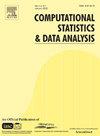重复功能数据的融合回归方法
IF 1.5
3区 数学
Q3 COMPUTER SCIENCE, INTERDISCIPLINARY APPLICATIONS
引用次数: 0
摘要
考虑了重复功能数据的线性回归和分类方法。对于样本中的每个统计单元,在与某些邻域结构(空间、群体等)相关的不同条件下,会随时间观测到一个实值参数。为了考虑这种结构引起的依赖性,提出了两种基于融合惩罚的回归方法。这些方法旨在通过确定近似条件是否与共同的回归系数函数相关联,从而获得简洁的系数回归函数。第一种方法是将基于 1-nearest neighbor 的变量融合方法推广到函数数据中。第二种方法依赖于分组融合套索惩罚,它假定条件具有一定的分组结构,并允许组内回归系数函数之间具有同质性。本文介绍了数值模拟和脑电图数据的应用。本文章由计算机程序翻译,如有差异,请以英文原文为准。
Fusion regression methods with repeated functional data
Linear regression and classification methods with repeated functional data are considered. For each statistical unit in the sample, a real-valued parameter is observed over time under different conditions related by some neighborhood structure (spatial, group, etc.). Two regression methods based on fusion penalties are proposed to consider the dependence induced by this structure. These methods aim to obtain parsimonious coefficient regression functions, by determining if close conditions are associated with common regression coefficient functions. The first method is a generalization to functional data of the variable fusion methodology based on the 1-nearest neighbor. The second one relies on the group fusion lasso penalty which assumes some grouping structure of conditions and allows for homogeneity among the regression coefficient functions within groups. Numerical simulations and an application of electroencephalography data are presented.
求助全文
通过发布文献求助,成功后即可免费获取论文全文。
去求助
来源期刊

Computational Statistics & Data Analysis
数学-计算机:跨学科应用
CiteScore
3.70
自引率
5.60%
发文量
167
审稿时长
60 days
期刊介绍:
Computational Statistics and Data Analysis (CSDA), an Official Publication of the network Computational and Methodological Statistics (CMStatistics) and of the International Association for Statistical Computing (IASC), is an international journal dedicated to the dissemination of methodological research and applications in the areas of computational statistics and data analysis. The journal consists of four refereed sections which are divided into the following subject areas:
I) Computational Statistics - Manuscripts dealing with: 1) the explicit impact of computers on statistical methodology (e.g., Bayesian computing, bioinformatics,computer graphics, computer intensive inferential methods, data exploration, data mining, expert systems, heuristics, knowledge based systems, machine learning, neural networks, numerical and optimization methods, parallel computing, statistical databases, statistical systems), and 2) the development, evaluation and validation of statistical software and algorithms. Software and algorithms can be submitted with manuscripts and will be stored together with the online article.
II) Statistical Methodology for Data Analysis - Manuscripts dealing with novel and original data analytical strategies and methodologies applied in biostatistics (design and analytic methods for clinical trials, epidemiological studies, statistical genetics, or genetic/environmental interactions), chemometrics, classification, data exploration, density estimation, design of experiments, environmetrics, education, image analysis, marketing, model free data exploration, pattern recognition, psychometrics, statistical physics, image processing, robust procedures.
[...]
III) Special Applications - [...]
IV) Annals of Statistical Data Science [...]
 求助内容:
求助内容: 应助结果提醒方式:
应助结果提醒方式:


